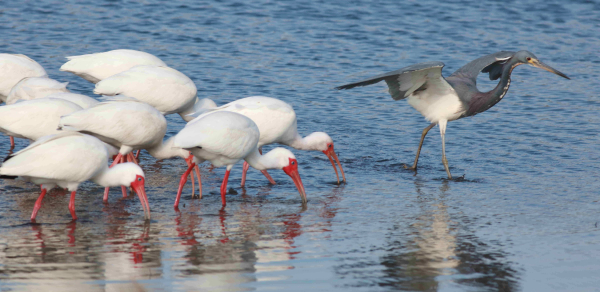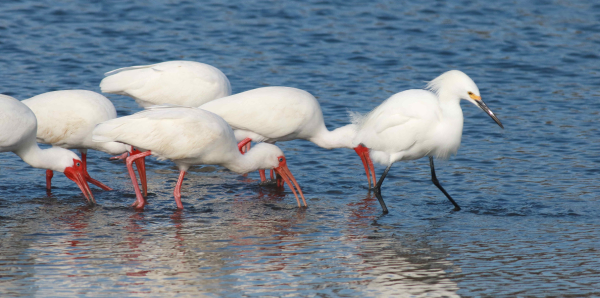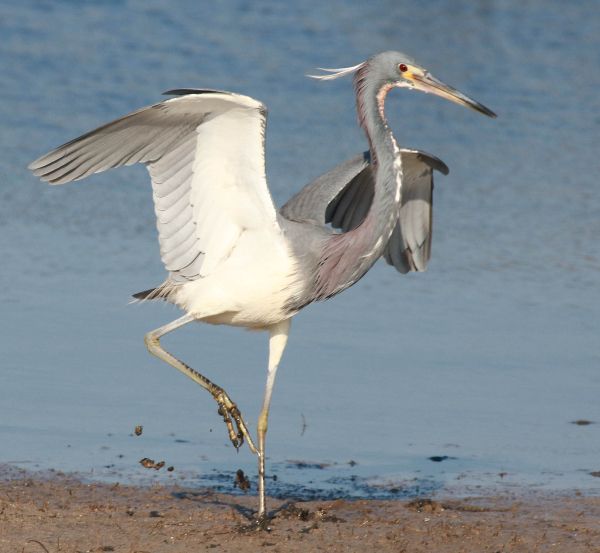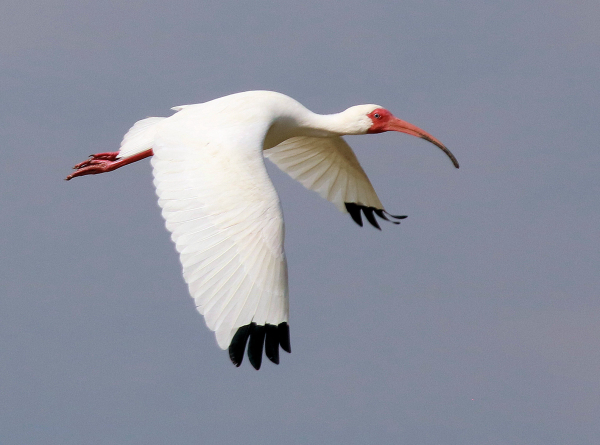At my first stop on the Texas Gulf Coast I spent a half hour photographing at a small pond adjacent to the beach where I sighted 3 White Ibis feeding along a trickle of water on a mudflat. The ibis led me to the small pond, where they joined 13 other White Ibis along with a Tricolored Heron and a Snowy Egret. It was most interesting to see the flock of White Ibis feeding in concert as a moving front, probing below the shallow water, and working their way before me in the beautiful morning light – close. Even more interesting was seeing the heron take a position in the midst of the advancing ibis, then move to the front of the flock to catch small fish.

It’s always satisfying to record the action and essence of the moment in a single photo frame as birds act and interact, as was the case with these White Ibis and the fishing Tricolored Heron.
The heron was quickly distracted, and the Snowy Egret followed the heron’s lead, and fished beside, then in front of the probing ibis. This was all happening quite quickly, as the phalanx of White Ibis moved across my view. Eventually other birds joined the breakfast activity at the pond, including 2 more Tricolored Herons, 2 Little Blue Herons, 2 Great Blue Herons, a Reddish Egret, and a Belted Kingfisher. Wow, although I was a little worried to be late and literally miss the boat (I was on the way to join a Whooping Crane cruise), but I had plenty of time and stayed to photograph for a good half-hour, with another half-hour to spare before embarking the ship at the port.

When the heron was distracted, the Snowy Egret took the lead to catch small fish before the probing red bills of the ibis.
The early morning lighting was fantastic at 9:30, and the activities of the birds was fun to photograph. I wanted a fast shutter speed to stop the action and keep the features of the birds sharp, but also needed a pretty wide depth of field to keep all the birds in focus. I had my aperture set at f8, which provided an adequately fast shutter speed of 1/1000 of a second. I probably would have liked to use an f10 or f11 aperture, but I stuck with my usual setting for full sun and hoped for the best – and it worked for the most part.
After the White Ibis marched past and began breaking into smaller groups, I had time to interact with some other birds photographically. One of the Tricolored Herons was quite aggressive toward another, chasing it into flight, following it, circling back and forth over the pond. It seemed to be related to pre-mating behavior, but the chased bird didn’t seem interested in the other. Nonetheless, it provided an opportunity to follow their flights and other antics with my camera. The chases led to one photo in particular that I share here when the aggressor landed in front of me, briefly holding its wings open and swirling into the sunshine. I really like that photo!

A split-second of time created this favorite image of a swirling Tricolored Heron in the morning sunlight – literally a 1/1250 split-second.
I also appreciated the opportunity to try to photograph a few of the birds when they took periodic flights over the pond, and especially liked the accompanying image of the White Ibis in flight. That image shows something of a 3-D dimension between the wings that was created by the shadow, the features of the bird are sharp, and its colors separate it from the uniform sky background. With the increased light of the sky, the shutter speed was 1/2000 of a second at f8.

This image of the White Ibis in flight shows a 3-D dimension between the wings that was created by the shadow; the features of the bird are sharp, and its colors separate it from the uniform sky background.
|
By that time I was eager to get to the ship, but especially glad to have had the extra time before the boat left the dock to stop and take advantage of a memorable birding event. Although I hesitated to leave such a productive photo site, sometimes quick and sweet works out well, and it certainly was a productive and fulfilling half-hour last Saturday morning.
Plus, I knew that was just the appetizer for the main course of the day – my upcoming photo sessions with the 2 pairs of Whooping Cranes we would encounter. What a wonderful way to begin my birding trip along the Gulf Coast of the United States, from the Mexican border to the southern tip of the Everglades. I’m looking forward to sharing more exciting hours spend afield with you, camera in hand, as this trip continues. In the meantime, enjoy the first week of spring!
Article and photographs by Paul Konrad
Share your bird photos and birding experiences at editorstbw2@gmail.com